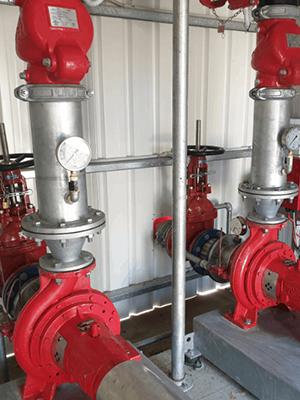Pump Room

Fire pumps are essential components of an industry or a building for the fire protection system. Fire pumps are critical in distributing water through sprinkler systems where water pressure from water mains and firefighting equipment cannot reach.
Fire pumps selections are as per NFPA 20, FM Standards, NBC 2016 Part 4 etc. A fire pump is an important part of a fire sprinkler, Fire hydrant, MVWS, HVWS, Deluge systems, as it provides high-pressure water accessibility to the fire system, increasing the flow rate of the water.
A fire pumping system is the combined system which is made up of the motor or driver, Pump and the controller.
Common type of fire pumps include the Centrifugal pumps, horizontal split case, vertical split case, vertical in-line, and vertical turbine.
Centrifugal pumps are the most common fire pumps and are used with most systems. With centrifugal pumps, pressure is developed principally by the action of centrifugal force or spinning. Water in centrifugal pumps enters the suction inlet and passes to the centre of the impeller. The rotation of the impeller, in turn, drives the water by centrifugal force to the rim where it discharges. Centrifugal pumps can handle large volumes of water while providing high pressure boosts.
With a horizontal split-case pump, the flow is split and enters the impeller from opposite sides of the pump housing. As the name implies, this is a pump installed with a split casing that can be opened for pump maintenance access and is connected to the driver by a horizontal shaft.
They are very reliable, come in a wide range of rated flow and pressure capacities, are easy to maintain due to their relatively easy split-case access, and can be used with both electric and diesel drivers. However, these also typically need the most space of all types of fire pumps A vertical turbine pump is the only type of pump allowed by NFPA 20, Standard for the Installation of Stationary Pumps for Fire Protection that can start with negative suction pressure or take water under a lift condition such as from a below grade source such as a river or subgrade tank. These pumps can be used with raw water sources such as ponds, lakes, and rivers. Vertical turbine pumps come in a wide range of capacities and pressures, and they can be used with diesel and electric drivers.
End Suction Pump
An end suction pump has a discharge outlet perpendicular to the suction inlet. These pumps are typically limited to a capacity of approximately 1,500 gpm (5,678 L/min). Compared to horizontal split-case fire pumps, they are more compact and require less installation space in a fire pump room
where available space is a concern. End suction pumps can be used with either an electric driver or a diesel driver.
Multistage Multiport Pump
Multistage Multiport pumps use a single-driver that can be either an electric motor or a diesel engine that connects to a pump with multiple impellers in series in a single casing driven by a horizontal shaft. The casing has multiple ports, or discharge outlets, delivering different pressures - each port has increased pressure from the consecutive series impellers.